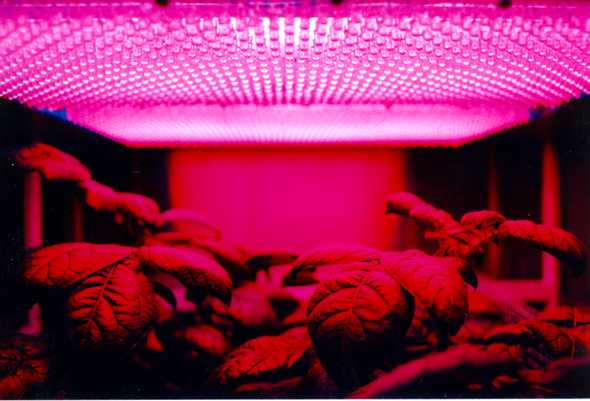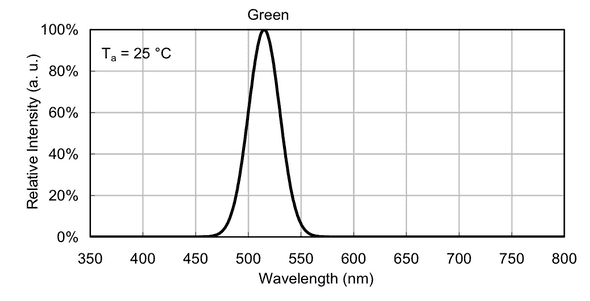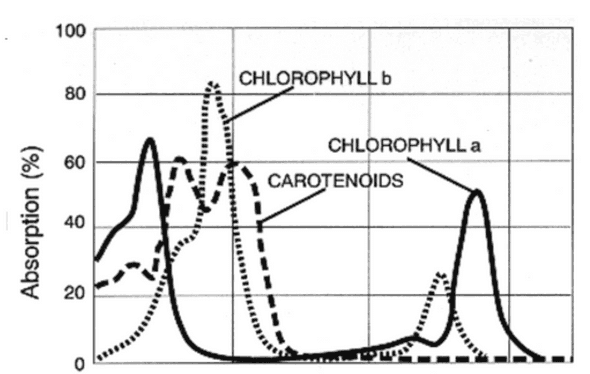LED panel light source used in an experiment on potato plant growth by NASA
LED, short for light emitting diode, is a very energy efficient way to provide your plants energy especially in winter. But beware, if you don’t get the right color of light, the plants will not grow well, no matter how much you spend.
If you are consider buying a new light setup for your plants, you should try LED lights. They are very energy efficient and better for the environment. The market is full of many types of LED lights for growing. Manufacturers try to confuse you with all kinds of specifications. In this article, we will cover the most important specifications you need to pay attention in order to make a wise choice.
For a quick answer, you can scroll down to Best color spectrum for LED grow lights. If you want to understand why this spectrum is the best, read the whole article. I will try to cover this topic as simply as possible.
What is Color Spectrum
Light color is measured in wavelength nm (nanometer). Any color has a specific wavelength. A color spectrum describes the visible light spectrum from the lowest to the highest visible wavelength, like a rainbow. The lowest wavelength is violet with 380 nm, the highest red with 740 nm. All other colors lay in between these wavelengths.
Color Spectrum of the Sun
Our Sun is a gigantic fusion reactor. With this powerful energy source the sun provides the full visible color spectrum and beyond. The solar radiation spectrum includes the full color spectrum and bands between 100 nm and 1000 nm.
Color Spectrum of LED
In general LEDs have a very narrow light spectrum. For example a green LED is specified with 515 nm peak intensity. With these LEDs are very energy efficient because they emit almost only the spectrum they are designed for.
Example LED Kingbright Intensity vs Wavelength
Which Color Spectrum do Plants Use
There is a big myth around that plants only use blue and red light for growing.
This misunderstanding come from the fact that photosynthesis use red and blue light the most to produce energy for the plant. Chlorophyll b and Chlorophyll a are responsible to allow plants to absorb energy from light.
Absorbance spectra of chlorophyll
But there is more …
Green, Yellow and other colors penetrates deeper into the leaf interior and can drive photosynthesis more efficiently than only red and blue light. [1]
Why the different colors? NASA research findings include the following:
Red Light (630-660 nm) is essential for the growth of stems, as well as the expansion of leaves. This wavelength also regulates flowering, dormancy periods, and seed germination.
Blue Light (400-520 nm) needs to be carefully mixed with light in other spectra since overexposure to light in this wavelength may stunt the growth of certain plant species. Light in the blue range also affects the chlorophyll content present in the plant as well as leaf thickness.
Green Light (500-600 nm) was once thought not to be necessary for plants, but recent studies have discovered this wavelength penetrates through thick top canopies to support the leaves in the lower canopy.
Far Red Light (720-740 nm) also passes through dense upper canopies to support the growth of leaves located lower on the plants. In addition, exposure to IR light reduces the time a plant needs to flower. Another benefit of far red light is that plants exposed to this wavelength tend to produce larger leaves than those not exposed to light in this spectrum.
Myth White Light is Always Good
After the previews topics some people came to the conclusion that white light is always the best. It is not!
White light is not important for plants, having the right intensity of each wavelength is important!
Making a lot of white light is a waste of energy.
Photosynthetically active radiation - PAR
But, how you can achieve the right intensity of each wavelength?
Luckily there is a spectral range called PAR, Photosyntheticall Active Radiation which is designed to include all for photosyntehiss relevant wavelengths. It is designed to reach high efficiency by excluding not relevant wavelengths.
Photosynthetically active radiation
Best Color Spectrum for LED Grow Lights
Use a Grow LED within the PAR spectrum. With the PAR spectrum your plant is happy to get all the relevant wavelengths for photosynthesis, and it will keep your energy bill low.
If you like the post, please share and subscribe our newsletter for future updates!